
The black hornet, or Dybowski hornet (Vespa dybowskii), is one of the rarest hornets in our country. The number of this species in our territories is so small that it, for example, is listed in the regional Red Book of the Chita region. In addition to Transbaikalia, this insect can occasionally be found in Primorye and the Amur Region. The main habitat of the black hornet is located in China, India, Burma, Thailand, Japan and Korea.
It is noteworthy that if we consider all areas of the habitat of this species as a whole, then it is impossible to unequivocally state its small number. This fact is explained by the fact that the rarity of encounters with an insect does not quite accurately reflect its actual prevalence.

Within the framework of the area as a whole, the black hornet is not an insect at all. Just because of some features of their biology, these hornets, in principle, never and nowhere are numerous - even in the main habitats. However, this species has a stable population.
What does the black hornet look like?
Externally, the black hornet is different from the usual for our country hornet ordinary just full black belly. If you compare these insects, for example, from photographs, then you will not find any difference in other elements of coloring: the head of the first type will literally exactly repeat the pattern on the body of the second, well known to many summer residents of the European part of Russia.
In the photo - the black hornet in its natural habitat:
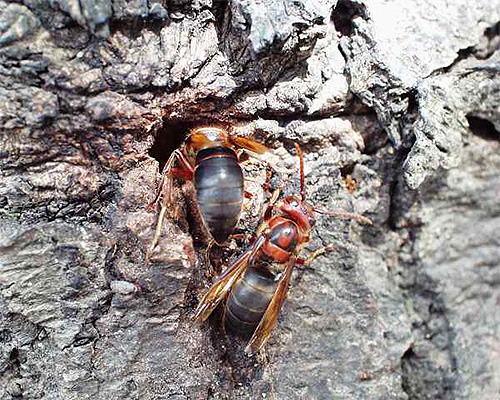
And this is what the hornet ordinary looks like:
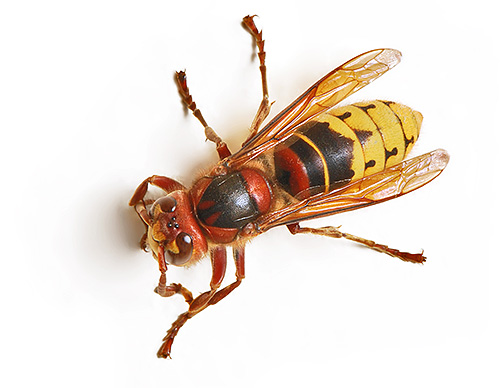
It is worth noting that the entomologist can find another one, albeit not so expressive, the difference between these insects: the black hornet, unlike the ordinary one, has brownish wings, which, however, are not strongly striking against the background of the black abdomen:
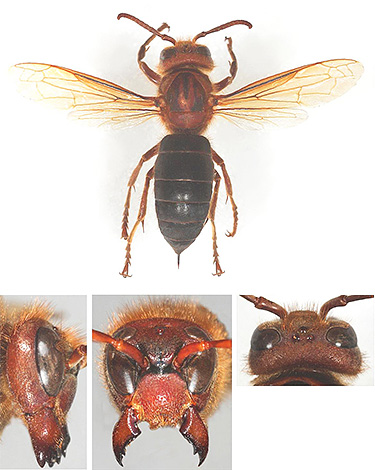
These insects do not possess outstanding size - they have rather average indicators by genus. The female reaches a length of 28-31 mm, working individuals - 18-23 mm, and males - 22-25 mm. Nevertheless, due to the monochromatic coloration, the body of insects of this species appears more slender and elongated in length than in typical “striped” relatives.
Interestingly, because of the characteristic coloring of black hornets, they are often mistaken for other insects. This is especially important for the southern regions of our country, where huge wasps of Scolia are found in abundance. Let's take a closer look at this interesting topic.
Who can be confused with black hornets?
Indeed, externally, the scoli very strongly resemble hornets, because both of them belong to the same family and therefore have a characteristic similar color. But unlike ordinary wasps or, for example, bumblebees, scoli, as well as hornets, can reach impressive sizes.
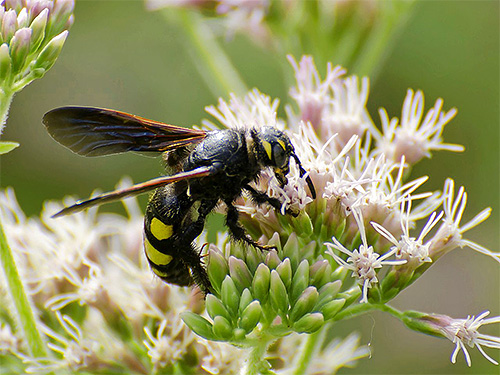
Thus, the average length of the body of females is 45 mm, but for some very large species, these figures are even longer - up to 60 mm. Thus, when determining insects, it is not worthwhile to focus only on the size of their bodies.
The main difference between the scoli and the common hornet is its dark color. But how, then, to distinguish between scolia and black hornet? Scientists-entomologists know that the usual giant scoliium has two transverse orange stripes on the black abdomen, but for ordinary eyewitnesses such subtleties are not known, so they are likely to accept it as the black hornet.
For clarity and a better understanding of the issue, let's turn to the photos of all listed insects.
On the first photo - the black hornet:
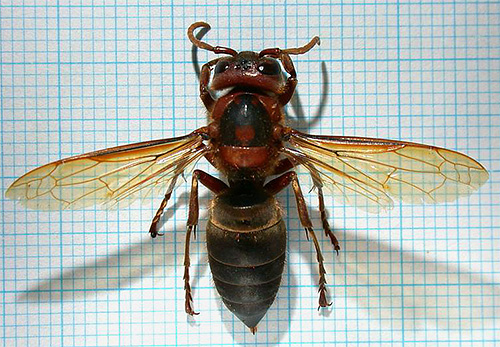
Here is the common hornet:

And in this photo - giant scolia:
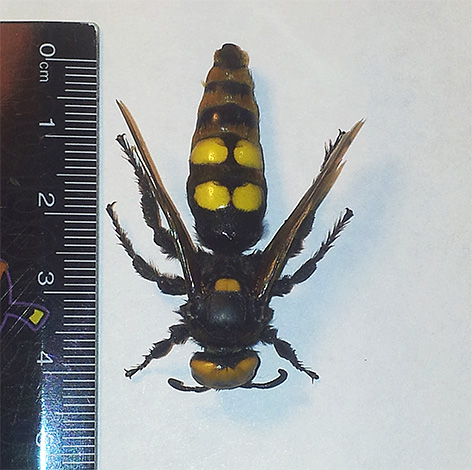
So, it is not so difficult to distinguish a black hornet from a scoli, it is only necessary to carefully examine their abdomen. The first insect has no spots and stripes here, the second one is decorated with yellow dressings.
In addition, the black hornet is not found west of Lake Baikal, so all meetings with a large black wasp in the European part of Russia are always meetings with cholies.
It is interesting
Scolls - insects are not social. Unlike hornets, they do not have nests; they do not live in families. Adult individuals usually feed on flowers, which cannot be said of their larvae. Females for procreation are found under the ground and with the stones of the larvae of large beetles, paralyzing them with their poison and laying eggs on the body. Thus, the larvae of Scoles feed on live, but immobilized larvae of beetles. Thanks to such a food source, the larvae pupate, hibernate under the ground, and the next year they get out of the cocoon, come to the surface of the earth and fly away.
There are cases when cholium was even mistaken for bumblebees, but such a mistake could only be made by people very far from entomology, because the difference between these insects, despite their belonging to the same family, is generally large enough. So, scolium has a typical aspen waist and slender belly, the bumblebee, on the contrary, is dense and very wide.


A pair of black bumblebee-hornet is just as striking as a bumblebee with scoli - it will be very difficult to confuse them at least once in the photo.
The only nest parasite among fellow
The most important and especially interesting feature that distinguishes black hornets from other hornets is their way of life. Of all 23 species of its brethren, black is the only nested parasite.
At the end of the summer, the young female finds a fairly large nest of ordinary or medium-sized ones. japanese hornets, penetrates it and kills the uterus.
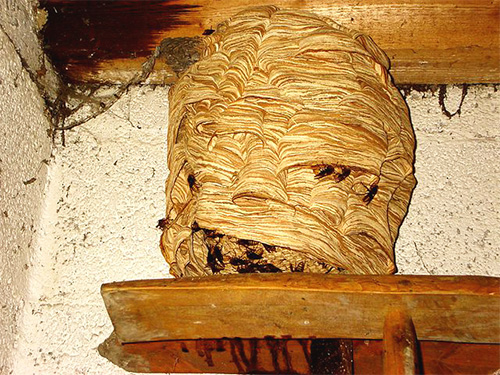
After that, the invader female with the help of special pheromones disguised as family members, individuals of which, guided by smell, immediately recognize her as their queen. Despite the fact that the new inhabitant of the nest belongs to a completely different species, the working individuals, confused by its smell, begin to serve the new uterus with the same zeal.
After capturing the nest, the black hornet female immediately starts laying in advance fertilized eggs, from which then individuals capable of breeding are then removed. Thus, throughout the development of the larvae of one species, the deceived workers of the other species nourish.
When the number of females and males becomes sufficient, they leave the nest and mate. Males soon die, and females find places for wintering or, if it happens in the tropics, new families for parasitism.
In the photo - black hornet on the tree bark:
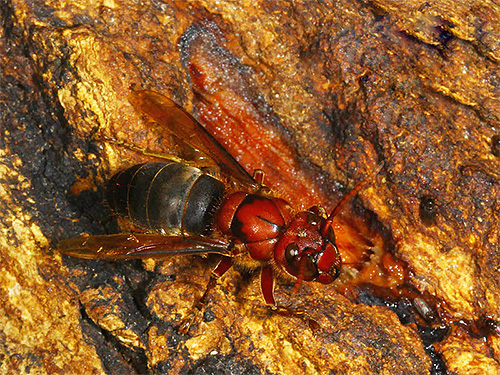
It should be noted that the capture of the nest, despite the simple algorithm, is given to the females of the black hornet is not easy. The overwhelming majority of them die from the “hands” of working individuals, who zealously protect their dwelling.
Until the moment of the murder of the old uterus, a new one is never recognized in the family. However, those rare lucky women who manage to conquer the nest ensure the appearance of such a large number of young individuals, which more than covers the death of less fortunate sisters.
It is clear that individual females who are looking for a nest are not as often seen as, say, numerous working individuals of a large family.That is why even in places of its usual habitat, black hornets, unlike hornets of other species, are not considered widespread.

In exceptional cases, these insects can organize their own nests and live in families. This behavior is manifested very rarely in them and is primarily explained by the fact that in some places of the range of hornets other small species may not be present at all. In this case, the search for an object for parasitization will definitely end in failure, and even the probable presence of larger species in the territory of hornets will not save the situation: giant hornets black can not parasitize.
How dangerous are black hornets?
If we talk about the attacks of the black hornet on a person, then we can say that this insect stings much more painfully than the usual hornet we are used to. But at the same time, its bite is not so terrible, as, for example, stinging with a giant Asian hornet living approximately in the same territories.
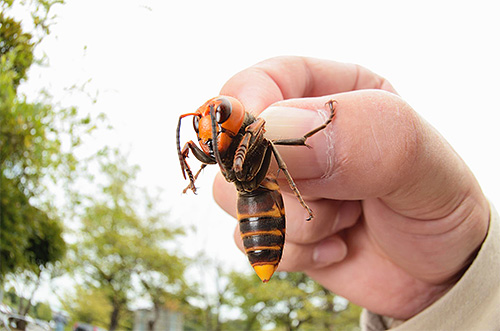
The fact that the giant hornet is leading black in the matter of toxicity of poison is an indisputable fact, because this insect is in principle one of the most poisonous insects on Earth.But why then, having approximately the same size, the other two hornets - black and ordinary - sting in different ways?
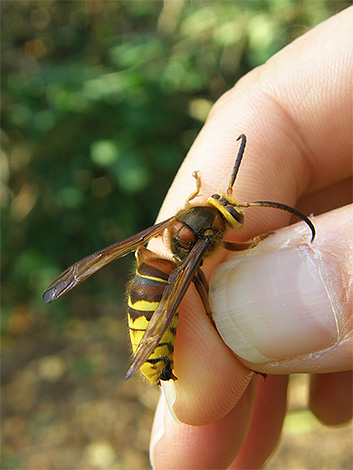
The fact is that to achieve success in capturing the nest, the black hornet female must be able to kill the uterus with its bite. However, theoretically, the old female should be resistant to the poison of the conqueror, because they both belong to the same genus and have toxins similar in composition. However, nature, “teaching” the black hornets to parasitize, rewarded them with a special poison containing additional enzymes and toxins, without which victory over the old uterus would have been impossible.

As for the person, for him the encounter with the black hornet ends in about the same way as with any other poisonous insect: first of all, there is a very strong throbbing pain. Immediately after the bite, a progressive inflammation appears on the affected area, the tissues harden, and severe itching can be felt. In addition, a stung person often has an increased heartbeat and shortness of breath.
If an allergic reaction joins the main symptoms, severe pains in the head appear, mucous membranes swell, and development of Quincke edema becomes possible. In about 5-6% of cases, anaphylactic shock occurs after being bitten by a black hornet, in which the absence of urgent medical care can be fatal.
It is interesting
The bites of cholium, unlike the bites of black hornets, are low-risk and practically painless. This is explained by the fact that the first insect uses its poison for protection, therefore its bite should cause a quick and sharp pain. The second uses its toxin to immobilize the victim, and it is for this reason that, of all the possible active components, its poison contains mainly paralytic substances.

First aid for stinging a black hornet must include all standard actions in such cases, namely:
- a cold compress should be applied to the affected area as soon as possible;
- to eliminate or alleviate a possible allergic reaction, you need to drink Suprastin or another antihistamine and carefully monitor your own condition;

- if you experience pain in your head, dizziness, high temperature, you should immediately call an ambulance or look for any other way to get to the hospital.
Remember - the sensitivity to insect venom is in no way dependent on your physical condition.
In conclusion, it is impossible not to mention that, like most of their relatives, the black hornet is a peace-loving insect, it will sting a person only in self-defense. If you do not touch this insect, do not try to kill it, and do not make sudden movements near the nest, it will never attack first.
At the same time, this hornet is able to provide invaluable assistance in the garden: it is with great pleasure that it kills various agricultural pests. So take care of the rare black hornets, respect their right to exist and use their services to exterminate harmful insects for free!
Useful video: about the danger of hornets bites and the rules of first aid to the victim
Hornet attack on man
Insect Fights: Scorpion vs. Hornet

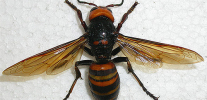
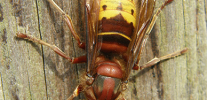

Thank. Helped on the lessons of ecology.
God) Thanks, it helped in the lesson!
thank
I have a pair of black bumblebees in my garden, in the trunk of an old apple tree. Made two entrances and two exits. I wanted to evict them with water. Insert the hose into the barrel. But I read it and decided not to touch it, let it live.